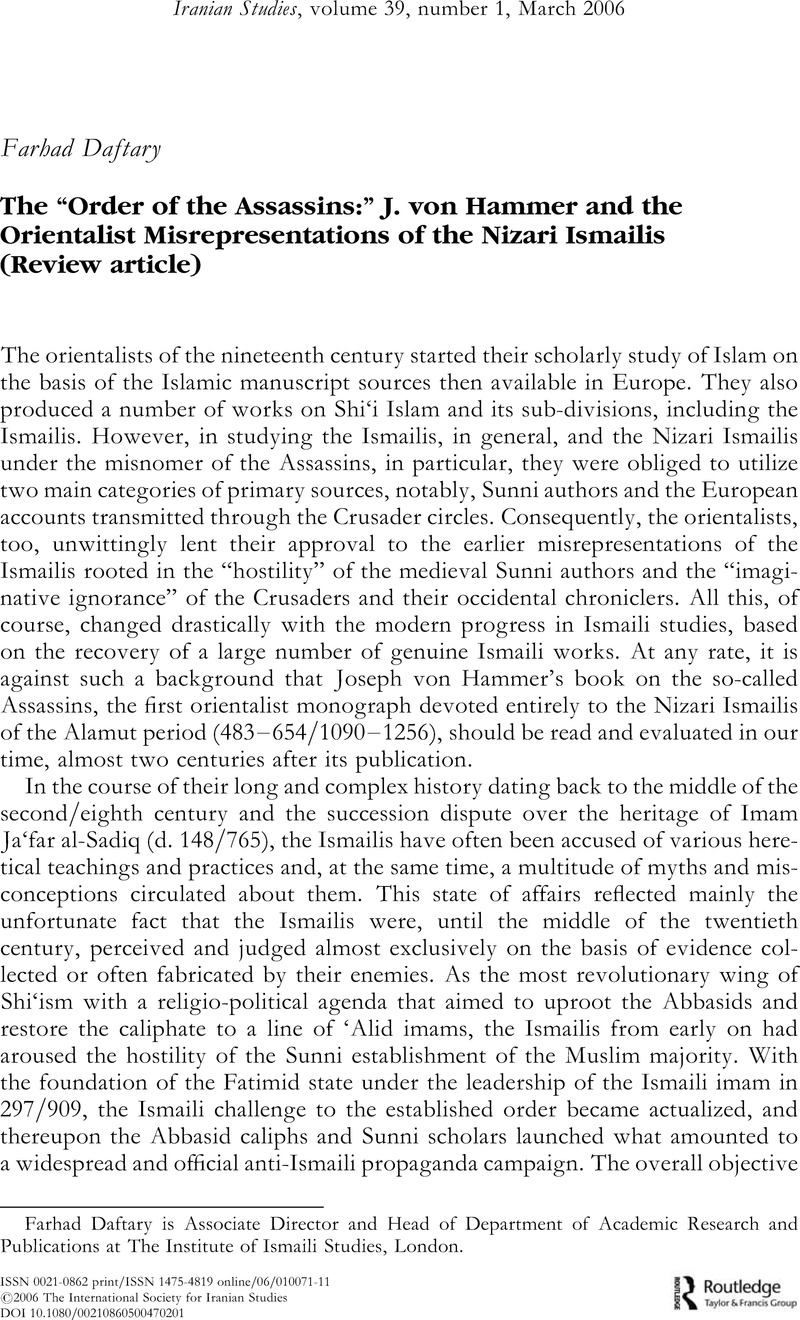Article contents
The “Order of the Assassins:” J. von Hammer and the orientalist misrepresentations of the Nizari Ismailis (Review article)
Published online by Cambridge University Press: 01 January 2022
Abstract

- Type
- Articles
- Information
- Copyright
- Copyright © 2006 The International Society for Iranian Studies
References
1 Tahir al-Baghdadi, ‘Abd al-Qahir b., al-Farq bayn al-firaq, ed. Badr, M. (Cairo, 1328/1910), 265–299Google Scholar; English trans., Halkin, A.S., as Moslem Schisms and Sects (Tel Aviv, 1935), 2:107–157Google Scholar.
2 Daftary, F., “Carmatians,” Encyclopaedia Iranica, 4:823–832Google Scholar.
3 For a pioneering study on this “black legend,” see Ivanow, W., The Alleged Founder of Ismailism (Bombay, 1946)Google Scholar.
4 al-Mulk, Nizam, Siyar al-muluk (Siyasat-nama), ed. Darke, H. (2nd ed., Tehran, 1347 Sh./1968), 311Google Scholar; English trans., Darke, H. as The Book of Government, or, Rules for Kings (2nd ed., London, 1978), 231Google Scholar.
5 Muhammad al-Ghazali, Abu Hamid, Fada'ih al-Batiniyya, ed. Badawi, ‘A. (Cairo, 1964), 21–36Google Scholar.
6 See, for instance, al-Din b. Isma‘il, Abu Shama Shihab, Kitab al-rawdatayn fi akhbar al-dawlatayn (Cairo, 1287–88/1870–71), 1:240, 258Google Scholar; Muyassar, Ibn, Akhbar Misr, ed. Sayyid, A.F., (Cairo, 1981), 102Google Scholar.
7 For a survey of these legends, see Daftary, F., The Assassin Legends: Myths of the Isma‘ilis (London, 1994), 88–127Google Scholar.
8 Polo, Marco, The Book of Ser Marco Polo, the Venetian, Concerning the Kingdoms and Marvels of the East, ed. and tr. Yule, H., 3rd revised edition by Cordier, H. (London, 1929), 1:139–146Google Scholar.
9 Falconet, Camille, “Dissertation sur les Assassins, peuple d'Asie,” in Mémoires de Littérature, tirés des registres de l'Académie Royale des Inscriptions et Belles Lettres, XVII (1751), 127–170Google Scholar; English trans., “A Dissertation on the Assassins, a People of Asia,” in John of Joinville, Memoirs of John Lord de Joinville, tr. Johnes, T. (Hafod, 1807), 2:287–328Google Scholar; Mariti, Giovanni F., Memorie istoriche del popolo degli Assassini e del Vecchio della Montagna, loro capo-signore (Leghorn, 1807)Google Scholar.
10 Silvestre de Sacy, Antoine I., “Mémoire sur la dynastie des Assassins, et sur l'étymologie de leur nom,” in Mémoires de l'Institut Royal de France, IV (1818), 1–84Google Scholar; reprinted in Turner, Bryan S., ed., Orientalism: Early Sources, Volume I, Readings in Orientalism (London, 2000), 118–169Google Scholar; English trans., “Memoir on the Dynasty of the Assassins, and on the Etymology of their Name,” in Daftary, Assassin Legends, 136–188.
11 See Bruijn, J.T.P. de, “Hammer-Purgstall,” Encyclopaedia Iranica, 11: 644–646Google Scholar, where further references are cited. One of von Hammer's critics, himself a Prussian diplomat and another source of inspiration for Goethe's encounter with the East, devoted an entire monograph to exposing the alleged superficiality and ignorance of this orientalist; see von Diez, Heinrich Friedrich, Unfug und Betrug in der morgenländischen Literatur nebst vielen hundert Proben von der groben Unwissenheit des Herrn von Hammer in sprachen und Wissenschaften (Berlin, 1815)Google Scholar.
12 Joseph von Hammer, Die Geschichte der Assassins aus Morgenländischen Quellen (Stuttgart and Tübingen, 1818).
13 Hammer, J. de, Histoire de l'ordre des Assassins, tr. Hellert, J.J., and de la Nourais, P.A., (Paris, 1833Google Scholar; reprinted, Paris, 1961); English trans., The History of the Assassins, derived from Oriental Sources, tr. Wood, Oswald C. (London, 1835Google Scholar; reprinted, New York, 1968).
14 The author possesses another obscure reprint of the English version with an introduction by S. Shraddhananda Sanyasi (Benares, 1926). Stark, Freya (1893–1993), the noted British traveler to the Alamut valley, for instance, cites von Hammer as a main authority in her The Valleys of the Assassins and Other Persian Travels (London, 1934), 228Google Scholar. Some authors of popular works on the subject still take von Hammer seriously; see Frère, Jean Claude, L'ordre des Assassins (Paris, 1973)Google Scholar.
15 See von Hammer, History, 136–138.
16 Hammer, J. von, “Sur le paradis du Vieux de la montagne,” Fundgruben des Orients III (Vienna 1813), 201–206Google Scholar.
17 von Hammer, History, 136.
18 von Hammer, History, 2.
19 See Daftary, F., Ismaili Literature: A Bibliography of Sources and Studies (London, 2004), 369–370Google Scholar, 386–388.
20 von Hammer, History, 1–2.
21 von Hammer, History, 163.
22 von Hammer, History, 164.
23 von Hammer, History, 48–49.
24 von Hammer, History, 72.
25 See Daftary, F., The Isma'ilis: Their History and Doctrines (Cambridge, 1990), 334–371Google Scholar; idem, “Hasan-i Sabbah and the Origins of the Nizari Isma'ili Movement,” in Daftary, F., ed., Mediaeval Isma'ili History and Thought (Cambridge, 1996), 181–204Google Scholar, where further references are cited.
26 von Hammer, History, 218.
27 von Hammer, History, 217.
28 See, for instance, Wasserman, J., The Templars and the Assassin: The Militia of Heaven (Rochester, VT, 2001)Google Scholar.
29 von Hammer, History, 105–106, 125, 155, 216. In this respect, see also Hodgson, Marshall G.S., The Order of Assassins: The Struggle of the Early Nizari Isma‘ilis against the Islamic World (The Hague, 1955), 26–28Google Scholar, 119.
30 Hodgson, M.G.S., “The Isma‘ili State,” in The Cambridge History of Iran (Cambridge, 1968), 5:422CrossRefGoogle Scholar n.1.
31 Lewis, B., The Assassins: A Radical Sect in Islam (London, 1967), 18–19Google Scholar.
- 3
- Cited by


